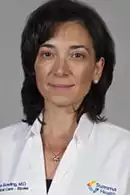Outstanding Stroke Care at Summa Health
Posted May 08, 2018 by Susana M. Bowling, M.D., FAHA
In May, we celebrate Stroke Awareness Month. Stroke is the fifth leading cause of death and the leading cause of adult disability. A stroke occurs when part of the brain does not get blood flow. A blood clot can block a blood vessel or artery, or a blood vessel can break. When this occurs, brain cells die quickly. When the cells die, the body loses control of the abilities that area of the brain once controlled.
At Summa Health, we provide award-winning stroke care and have the ability to care for all types of strokes. In the last 10 years, more than 7,000 patients have suffered a stroke and received care with us. Over 3,000 stroke teams have been called, and over 600 patients have been treated with acute rescue treatments at Summa.
It is with great pride that I announce the recent recertification of our Stroke Center. It has been nearly ten years since its original certification. Our quality shines across our community, state and country. We are the ONLY hospital in the Akron area to have received the American Stroke Association Get with the Guidelines Gold Plus Award since 2010. In addition to quality, we added speed, and for the past two years, we have also been awarded for treating our patients faster than national benchmarks, achieving maximum recognition as Honor Roll Elite Plus.
Why is speed important? Because time is the brain, and every minute we wait, 2 million brain cells die. Speed helps improve outcomes and helps protect our patients’ futures. So the fact that we averaged 49-minute treatment times in 2017, 11 minutes faster than the national benchmark of 60 minutes, is a big deal for our patients. That’s a savings of approximately 22 million brain cells per patient. And the fact that we beat the national standard of 60 minutes 87 percent of the time on average is an even bigger deal. Compare those numbers to 70 percent for other hospitals in Ohio and across the nation. These numbers are important for our community members who can rest assured knowing that Summa Stroke Team will RUN for them when the time comes.
Why do so few patients fail to receive clot-busting treatment that can reduce disability? It is because they either do not recognize the signs of a stroke or wait too long to seek treatment. Do you know the warning signs of a stroke?
- Sudden numbness or weakness of the face, arm or leg, especially on one side of the body
- Sudden trouble speaking or understanding
- Sudden trouble seeing in one or both eyes
- Sudden trouble walking, dizziness or loss of balance
- Sudden severe headache
Act FAST! Call 911 immediately in the community for any sign of stroke.
In 2015, Summa launched a telestroke program at both Akron and Barberton Campuses, allowing stroke expert physicians to be at the bedside of patients within minutes, day or night. The introduction of telestroke services helped facilitate faster treatment times.
We have also strengthened our acute aneurysm rupture (Subarachnoid hemorrhage) program by offering a less invasive treatment option. I am particularly proud of this program because it is a true collaboration between clinicians across institutions to achieve the best care for patients with the goal of keeping patients in the community.
Our success is due to a great partnership with our community EMS providers and collaboration from so many different departments: ED, radiology, residents, nursing, critical care, lab, rehab services, pastoral care, cardiology, palliative care and research. The success of our stroke care is truly a success for our community.
Summa Health Neuroscience Institute has several facilities throughout Northeast Ohio, serving patients with locations in Akron and Barberton. To get started, select a location nearest you or call 330.319.9495 today for assistance.
Related Links:
About the Author
Vitality eNews Sign Up
Receive the Summa Health eNewsletter for the latest health tips, advice and updates.


